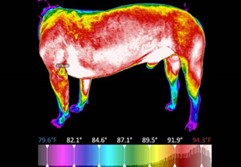Companion Animal Thermal Imaging - Digatherm®
Companion animals are not able to show or tell us where their problems are. Digatherm®’s thermal imaging system solves that problem by letting us see the unseen and listen to what patients cannot tell us.
Veterinarians utilize companion animal thermal imaging to see the unseen. First, a clinician must understand normal physiology in order to compare it to their patient’s current state.
Normal blood flow in cats and dogs’ results in symmetrical surface temperatures on both sides. Unhealthy patients can become non-symmetrical. At the same time, tissue changes can result in abnormal blood flow and non-symmetrical surface temperatures. Unexpected warmer or cooler areas, or asymmetry within the patient, distinguishes physiological change. Contralateral differences in temperature are also significant.
Increased temperatures (hyperthermia) are a direct result of increased blood flow. This may be due to inflammation, infection, or malignancy. Decreased temperatures (hypothermia) are a result of decreased blood flow. This is usually due to a neurological condition resulting in vasoconstriction. It is occasionally due to infarction or atrophy.
While thermal imaging cameras measure body surface temperatures, veterinary-specific software converts the temperatures into images. These thermal images use colors to represent the patient’s body surface temperatures. This provides a physiological map of the patient and in turn allows veterinarians to see the unseen.


Dr. Jyl Rubin DVM (916) 989-0738

